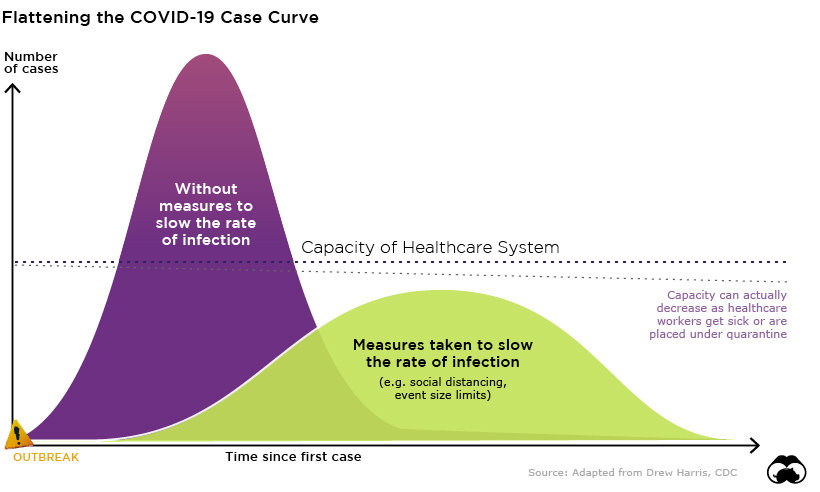How to flatten the curve
Spikes in COVID-19 outbreaks call for ways to keep infection rates down
Photo courtesy of the World Economic forum
Protective measures are necessary to flatten the local, national and international curves of the COVID-19 pandemic. The CDC recommends various measures to reduce the spread of the virus if used conjointly by everyone.
April 5, 2020
Since the first national case of the novel coronavirus in mid-January, the exponential growth of those contracting the illness has become the topic of discussion for 2020. Varying levels of worry span from going about with daily life to completely isolated from the outside world.
With the virus having more risks than the common flu, the spread can transmit similarly. The main and most effective difference being the lack of a coronavirus vaccine according to Healthline.
While some are convinced that the entire pandemic is nothing to worry about, most are well aware of the precautions encouraged by the Centers for Disease Control and Prevention, or the CDC, as well as local and national government officials.
According to Harvard’s Coronavirus research center, an epidemic curve is a statistical chart used to visualize new cases over a period of time. To “flatten the curve” means to slow down the number of new cases over a longer period of time to avoid as much damage as possible. To do so, protective measures must be put in place. This, in effect, would also help manage the rise of needed hospital equipment for incoming patients.
International hotspots for COVID-19 such as Italy and China have been able to flatten their national curves while the United States soars past their numbers with the most identified cases. An article published in CNBC states that within a span of weeks there have been dramatic decreases in their growth of known cases. Dramatic measures are put into place to receive such outcomes– closing borders and travel bans being the common ground between the two.
On March 11, 2020, the World Health Organization declared COVID-19 a pandemic when having met the identifications of being a disease outbreak occurring over a wide geographic area and affecting an exceptionally high proportion of the population as defined by Yale medicine.
Washing hands for at least 20 seconds and disinfecting items that come into contact with large numbers of bacteria are the primary ways in which people are staying safe. The sure-fire ways to stay clear of sickness are not touching the face with unwashed hands, avoiding contact with sick people and staying home when sick as stated in an article focused on the prevention of the coronavirus from Live Science.
Social distancing is one of the most commonly heard of ways to be cautious of spreading the virus. In the current case of Omaha, an article titled “Staying Ahead of the Curve” from the Nebraska Governor’s office says the state is enforcing restrictions of gatherings no larger than ten people and social distancing six feet apart following national guidelines. Cancellations of public events are taken as preventative measures to decrease the spread.
In a case study published by the New York Times, it was found that professionals are concerned that the government is not taking public health measures with the safety of the people into priority. Disagreements over the economic turmoil have spawned over the national government’s recommendations to keep non-essential businesses open and going against the word of experts.
Letting the problem fester without immediate action rapidly increases the number of cases as shown in growth rates from the first case to the recent cases as of March 31st. A live dashboard of corona cases worldwide from John Hopkins University (x) shows the jump from the first few worldwide infections to the thousands of new cases found daily.
Although there is no vaccine for COVID-19, researchers at the U.S. National Institutes of Health are in the process of creating a fighting solution. Experts are skeptical that creating a vaccine within the given 18-month time-span is possible, but scientists around the world are working for the cure as diligent and effective as possible.







